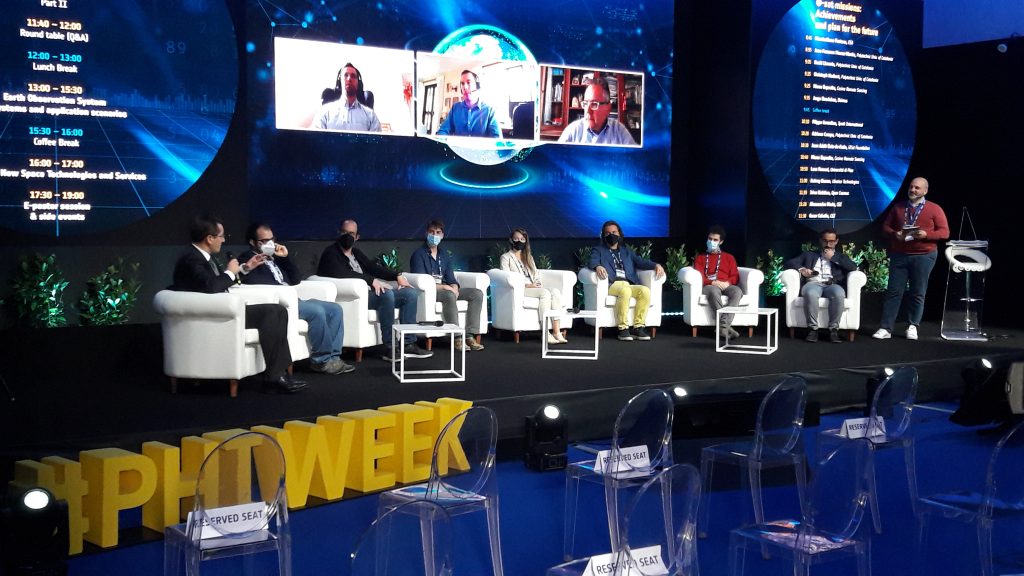Φ-week 2021: Φ-sat and the system-of-systems concept
Two key sessions on today’s Φ-week agenda painted a bright future for the proliferation of AI-backed Earth observation applications. With the latest news on the Φ-sat missions, together with examples showcasing the widening array of commercial and institutional use cases, the speakers presented a wealth of inspiring and thought-provoking material.
This morning’s session was devoted to the Φ-sat concept, covering both the achievements of the Φ-sat-1 experiment and the development of its next incarnation, Φ-sat-2. Launched just over a year ago, the Φ-sat-1 experiment was set up to study the impact of onboard Artificial Intelligence (AI) on EO data collection. The project developers Cosine Remote Sensing and the University of Pisa were on hand during the session to report on progress. Spain’s Universitat Politècnica de Catalunya was also well represented, with four talks on subjects such as soil moisture and sea-ice extent from the FSSCat cubesat-based mission, which is also hosting the Φ-sat-1 experiment.
Other Φ-sat-1 suppliers also took part, including Ubotica Technologies. The company presented results on a topic at the very heart of the Φ-sat-1 experiment mission: the Movidius Myriad 2 AI Accelerator. This chip is the engine behind the satellite’s data processing capabilities and, as Ubotica’s Chief Technology Officer Aubrey Dunne explained, its performance is being monitored continuously while in-flight: “Φ-sat-1 has provided unique in-flight performance data for the Myriad 2 AI accelerator, giving valuable insight into the reliability of the device and the accuracy of its AI computations. Results of in-flight self-test diagnostics from Φ-sat-1 indicate that Myriad 2 was 100% functional and performed all verifiable inference requests flawlessly, demonstrating the reliability and practicality of AI on cubesats and providing valuable flight heritage to support its integration into future AI-rich satellite missions.”
Φ-sat-2 is being developed by a group of entities across Europe. Lead company Open Cosmos was at the session to give an overview of the platform architecture and its key features. “The biggest challenge on this mission for us is facilitating all the needs of the AI applications that will be running onboard,” said Irina Babkina, Systems Team Lead for the Φ-sat-2 project at Open Cosmos. “What we’re working on at the moment to meet that challenge is ensuring that the application-enabling algorithms we’ll be running actually have the required performance.”
At the helm during the presentations and round-table discussion was ESA Φ-sat activity lead Massimiliano Pastena. He was impressed by the progress made on both mission variants: “Φ-sat-1 is generating useful data which is helping to demonstrate the worth of onboard AI in EO satellites. This is laying the foundation for the parallel development of Φ-sat-2, which is scheduled for launch next year. As we’ve heard today, the power to upload, deploy and update AI applications in orbit, almost as simply as we do on our smartphones, will ensure that Φ-sat-2 becomes the benchmark for the next generation of flexible, user-oriented nanosatellites.”
The theme of targeting user needs continued in the afternoon with the System of Systems session. Giuseppe Ottavianelli, Head of ESA’s Earth Observation Applications Section and one of the session chairs, outlined the scope of the gathering: “The system-of-systems concept is about the possibilities deriving from the synergy between publicly-funded EO missions and private commercial assets. With global coverage and the long-term availability of calibrated data, public missions such as the Copernicus Sentinels form a solid basis for commercial investments in terms of both the space segment and downstream value-adding industry, giving rise to a host of customer-tailored applications.”

The session provided a fitting exposition of the breadth of such applications. Alongside the more established areas of agriculture, forestry and coastal monitoring, the speakers also addressed infrastructure asset management, urban planning and even the use of Very High Resolution (VHR) data for security applications. One talk in particular, given by ESA CHIME Operations Manager Antonio Gabriele, highlighted the potential gains from public-private EO initiatives and explored the idea of a hybrid constellation of CHIME and VHR smallsats, along with the applications that could result from this combined fleet.
Commenting on this and the other talks in the session, Head of the ESA EO System Architect Office Antonio Ciccolella was upbeat about the prospects for continuing growth in the sector: “The CHIME+VHR hybrid idea shows just how the system-of-systems concept could bring significant benefits for society at large. Underpinned by technologies such as AI, the Internet of Things and Blockchains, we expect the emerging abundance of new hardware and applications to deliver what could be called the Future Earth Intelligence System. The presentation from Rafael Guzman of Satlantis is another concrete example of private-sector investment in space, complementing Copernicus observations and using Sentinel data as a reference for the endeavour.”
To know more: Φ-week, Φ-sat, Copernicus Sentinels, CHIME
Photo Copyright: ESA
